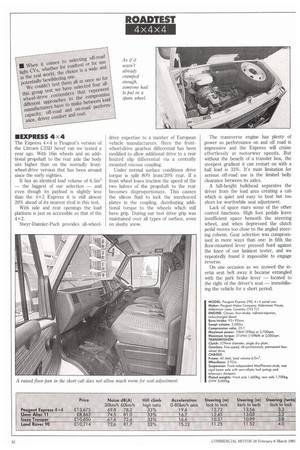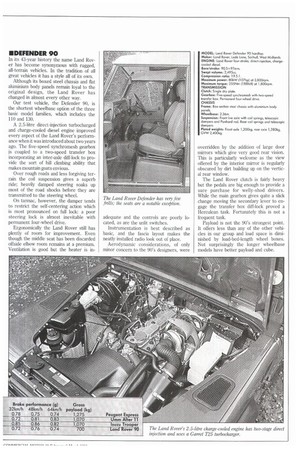• DEPRESS 4 x 4
Page 34

Page 35

If you've noticed an error in this article please click here to report it so we can fix it.
The Express 4x4 is Peugeot's version of the Citroen C25D Sevel van we tested a year ago. With 16in wheels and an additional propshaft to the rear axle the body sits higher than on the normally frontwheel-drive version that has been around since the early eighties.
It has an identical load volume of 6.5m3 — the biggest of our selection — and even though its payload is slightly less than the 4x2 Express it is still almost 20% ahead of its nearest rival in this test.
With side and rear openings the load platform is just as accessible as that of the 4 x 2.
Steyr-Daimler-Puch provides all-wheel drive expertise to a number of European vehicle manufacturers. Here the frontwheel-drive gearbox differential has been modified to allow additional drive to a rear limited slip differential via a centrally mounted viscous coupling.
Under normal surface conditions drive torque is split 80% front/20% rear. If a front wheel loses traction the speed of the two halves of the propshaft to the rear becomes disproportionate. This causes the silicon fluid to lock the interleaved plates in the coupling, distributing additional torque to the wheels which still have grip. During our test drive grip was maintained over all types of surface, even on slushy snow. The transverse engine has plenty of power so performance on and off road is impressive and the Express will cruise effortlessly at motorway speeds. But without the benefit of a transfer box, the steepest gradient it can restart on with a half load is 33%. It's main limitation for serious off-road use is the limited belly clearance between its axles.
A full-height bulkhead separates the driver from the load area creating a cab which is quiet and easy to heat but too short for worthwhile seat adjustment.
Lack of space mars some of the other control functions. High foot pedals leave insufficient space beneath the steering wheel, and when depressed the clutch pedal moves too close to the angled steering column. Gear selection was compromised in more ways than one: in fifth the floor-mounted lever pressed hard against the knee of our lankiest tester, and we repeatedly found it impossible to engage reverse.
On one occasion as we stowed the inertia seat belt away it became entangled with the park brake lever — located to the right of the driver's seat — immobilising the vehicle for a short period.
IIDEFENDER 90
In its 43-year history the name Land Rover has become synonymous with rugged, all-terrain vehicles. In the tradition of all great vehicles it has a style all of its own.
Although its boxed steel chassis and flat aluminium body panels remain loyal to the original design, the Land Rover has changed in almost every other way.
Our test vehicle, the Defender 90, is the shortest wheelbase option of the three basic model families, which includes the 110 and 130.
A 2.5-litre direct-injection turbocharged and charge-cooled diesel engine improved every aspect of the Land Rover's performance when it was introduced about two years ago. The five-speed synchromesh gearbox js coupled to a two-speed transfer box incorporating an inter-axle diff-lock to provide the sort of hill climbing ability that makes mountain goats envious.
Over rough roads and less forgiving terrain the coil suspension gives a superb ride; heavily damped steering soaks up most of the road shocks before they are transmitted to the steering wheel.
On tarmac, however, the damper tends to restrict the self-centering action which is most pronounced on full lock: a poor steering lock is almost inevitable with permanent four-wheel drive.
Ergonomically the Land Rover still has plently of room for improvement. Even though the middle seat has been discarded offside elbow room remains at a premium. Ventilation is good but the heater is in adequate and the controls are poorly located, as are the unlit switches.
Instrumentation is best described as basic, and the fascia layout makes the neatly installed radio look out of place.
Aerodynamic considerations, of only minor concern to the 90's designers, were overridden by the addition of large door mirrors which give very good rear vision. This is particularly welcome as the view offered by the interior mirror is regularly obscured by dirt building up on the vertical rear window.
'The Land Rover clutch is fairly heavy but the pedals are big enough to provide a sure purchase for welly-shod drivers. While the main gearbox gives quite a slick change moving the secondary lever to engage the transfer box diff-lock proved a Herculean task. Fortunately this is not a frequent task.
Payload is not the 90's strongest point. It offers less than any of the other vehicles in our group and load space is diminished by load-bed-length wheel boxes. Not surprisingly the longer wheelbase models have better payload and cube.












































































